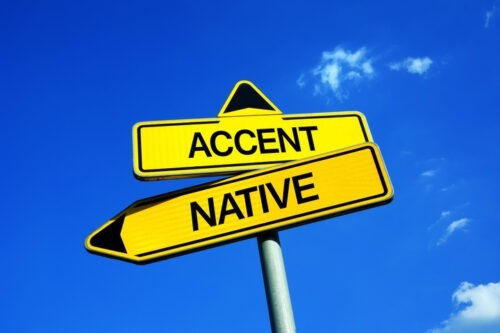Whether you’re producing a documentary, commercial, or animated series, understanding different accents helps your content resonate authentically with audiences.
At Voice123, the trusted voice over network for global creators, we understand that an accent is an important part of storytelling. But what is an accent, why do people have them, and how can you use them in voice over projects?
What is an accent?

An accent is the unique way people pronounce words, shaped by their region, culture, and native language. The accent definition refers to distinct pronunciation patterns in speech that reveal where a person comes from. Every language has countless types of accents, influenced by intonation, stress, and rhythm. These subtle changes make an American accent sound worlds apart from a British accent, even when the words are identical.
Think of an accent as a vocal fingerprint; it reveals a person’s background, personality, and even emotional tone. In voice over, accent pronunciation shapes how characters are perceived, allowing listeners to instantly connect to a story’s setting or a character’s mood.
Why do people have accents?
So, why do people have accents at all? It begins in childhood, when a person first learns to speak by mimicking their parents’ voices and local speech patterns. This linguistic foundation also plays a important role in differentiating dialect vs. accent. Over time, these features evolve based on:
- Geography: Coastal, urban, or rural environments influence how we form sounds.
- Culture: An accent often reflects identity and belonging within a community.
- Native language: When people learn new languages, their first language influences how they pronounce words, creating a foreign accent.
- Social exposure: The more we interact with people from other regions, the more our accent blends or shifts.
These factors explain why different accents can exist even within one city and why there’s no such thing as a single English accent. Instead, the general accent from America, the UK, and other English-speaking countries is constantly evolving and turning into new dialects.
How do accents develop?
Accents develop naturally through generations of linguistic adaptation. Environmental isolation or migration can shape how sounds are spoken. For instance, the clipped English accents of London evolved differently from the lilting tones of Northern England.
Phonetics also plays a huge role in establishing different types of accents. Some languages emphasize consonants, while others rely on vowel length or pitch. These differences explain why Spanish accents sound smooth and melodic, and why an American accent often features flattened vowel sounds.
What are the different types of accents?
1. American Accents
American accents include regional variations like Southern, New York, and Californian. The General American accent is the most neutral and widely used in film and advertising because of its clear pronunciation and broad appeal.
2. British Accents
British accents range from the posh Received Pronunciation (RP) to the working-class Cockney and musical tones of Scottish and Welsh dialects. Each English accent carries different social and emotional associations, making them perfect for defining character class or origin in storytelling.
3. Spanish Accents
Across Latin America and Spain, a Spanish accent varies in sound and rhythm. Accents in Spanish from Spain (Castilian) sound sharper, while Latin American varieties, like Colombian or Mexican, are softer and slower in tone. Directors often hire voice actors with a specific Spanish accent to match the cultural setting of the script.
4. European Accents
Beyond English and Spanish, European accents include French, Italian, and German styles that reflect their nations’ cultural richness. A European accent can lend sophistication, mystery, or authenticity to any performance.
To explore how localization works across these variations, check out Voice123’s dubbing guide.
How accents influence voice acting

For casting directors and producers, understanding voice accents can make or break a project. They help define characters, build immersive worlds, and enhance credibility.
When you hire a voice actor, their ability to master a different accent, from American to British or Spanish, ensures your message reaches audiences naturally. The right accent pronunciation can transform a generic script into an emotionally resonant performance.
At Voice123, you can find professional voice actors who specialize in English accents and multilingual delivery who can give your story an authentic voice.
Final Thoughts
Accents are the living soundtrack of human diversity. They connect us to our roots, our culture, and our emotions. Understanding what is an accent, and the main type of accent used globally gives you the creative edge when producing audio and video content.
Whether you’re after a smooth American accent, an articulate British accent, or a lively Spanish accent, Voice123 makes it easy to find professionals who deliver authenticity and nuance.
Post your project today and give your project the perfect accent.
FAQs
The General American accent is the most popular worldwide because it’s easy to understand and widely used in entertainment and media.
The top five are British, Australian, French, Italian, and Spanish, which are admired for their rhythm and charm.
They include American, British, Australian, Irish, Scottish, and Indian English. Each has a unique style of pronunciation and tone shaped by history and geography.
An accent is named geographically or culturally; the “Southern accent,” “Cockney accent,” or “Irish accent” identify English pronunciation based on region and language.
